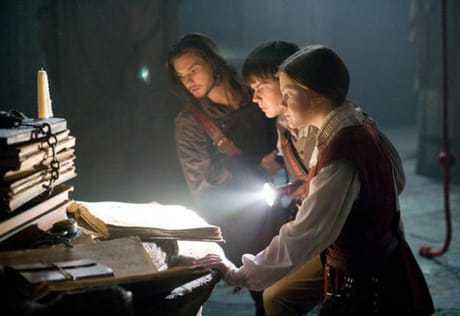After surmounting petty budget woes (Prince Caspian only made $419 million worldwide, the travesty!), the Narnia franchise is still on track, albeit with new, leaner studio coffers and a shift in the director's chair.
The Voyage of the Dawn Treader is where C.S. Lewis's series becomes a bit trickier to adapt, in the traditional Hollywood method of franchising. The two eldest Pevensie children ― primary characters coming into their own for the first two films ― have grown up and out of Narnia's need for them. Though Lucy has always been the emotional fulcrum of the series, now she and Edmund take the spotlight, being transported to Narnia through a leaking painting of a ship, along with their cousin, Eustace Scrubb. Caspian, now King, fishes the kids out of the ocean and onto his ship, the Dawn Treader. Thankfully, Ben Barnes has been directed to drop Caspian's cumbersome faux-Spanish accent of the previous film in favour of an across the board adoption of British.
The stakes are a little different this time out. Instead of a vital world or empire-threatening scenario, our young heroes are part of a grand quest. Seven swords from seven banished lords must be found and placed on Aslan's table to avert a green madness mist that's been causing disappearances in coastal settlements. There's a parade of luscious special effects throughout the film ― thankfully, the cost of CGI has dramatically lowered, so any penny-pinching isn't very visible on screen (okay, the Minotaur fur has lost some lustre). Liam Neeson is still on board to voice Aslan and the loss of Eddie Izzard as Reepicheep is barely noticeable when his replacement is Simon Pegg.
Voyage is stuffed to the gills with fantastic creatures, like single-footed gnomes, a dragon, water nymphs, sea monsters and, of course, the recurring visage of Tilda Swinton's White Witch to tempt and torment Edmund. Therein lies Dawn Treader's biggest narrative obstacle: there is no primary antagonist. Nearly all danger comes from within, and the battles, though spectacularly externalised to make one heck of an entertaining chapter in a grand fantasy epic, are those of self-discovery. Shifting the perspective from the Pevensies to Eustace unbalances the narrative a bit, especially since the burgeoning protagonist is such an insufferable twerp, until a plot device thankfully silences him. The 3D is mostly tastefully employed ― deepening facial contours and rounding out scenery ― though the gases between stars make the night sky look like lumpy hills (think somewhere between the quality of Alice in Wonderland and Avatar).
Its message of faith and religious allegory is as blunt as ever, but Narnia still sparkles with the magic of childlike wonderment. Voyage of the Dawn Treader provides a natural conclusion to the Pevensie arc of the Narnia story, but let's hope audiences have enough faith to watch a new set of young heroes bring the series to its proper conclusion.
(Fox)The Voyage of the Dawn Treader is where C.S. Lewis's series becomes a bit trickier to adapt, in the traditional Hollywood method of franchising. The two eldest Pevensie children ― primary characters coming into their own for the first two films ― have grown up and out of Narnia's need for them. Though Lucy has always been the emotional fulcrum of the series, now she and Edmund take the spotlight, being transported to Narnia through a leaking painting of a ship, along with their cousin, Eustace Scrubb. Caspian, now King, fishes the kids out of the ocean and onto his ship, the Dawn Treader. Thankfully, Ben Barnes has been directed to drop Caspian's cumbersome faux-Spanish accent of the previous film in favour of an across the board adoption of British.
The stakes are a little different this time out. Instead of a vital world or empire-threatening scenario, our young heroes are part of a grand quest. Seven swords from seven banished lords must be found and placed on Aslan's table to avert a green madness mist that's been causing disappearances in coastal settlements. There's a parade of luscious special effects throughout the film ― thankfully, the cost of CGI has dramatically lowered, so any penny-pinching isn't very visible on screen (okay, the Minotaur fur has lost some lustre). Liam Neeson is still on board to voice Aslan and the loss of Eddie Izzard as Reepicheep is barely noticeable when his replacement is Simon Pegg.
Voyage is stuffed to the gills with fantastic creatures, like single-footed gnomes, a dragon, water nymphs, sea monsters and, of course, the recurring visage of Tilda Swinton's White Witch to tempt and torment Edmund. Therein lies Dawn Treader's biggest narrative obstacle: there is no primary antagonist. Nearly all danger comes from within, and the battles, though spectacularly externalised to make one heck of an entertaining chapter in a grand fantasy epic, are those of self-discovery. Shifting the perspective from the Pevensies to Eustace unbalances the narrative a bit, especially since the burgeoning protagonist is such an insufferable twerp, until a plot device thankfully silences him. The 3D is mostly tastefully employed ― deepening facial contours and rounding out scenery ― though the gases between stars make the night sky look like lumpy hills (think somewhere between the quality of Alice in Wonderland and Avatar).
Its message of faith and religious allegory is as blunt as ever, but Narnia still sparkles with the magic of childlike wonderment. Voyage of the Dawn Treader provides a natural conclusion to the Pevensie arc of the Narnia story, but let's hope audiences have enough faith to watch a new set of young heroes bring the series to its proper conclusion.
